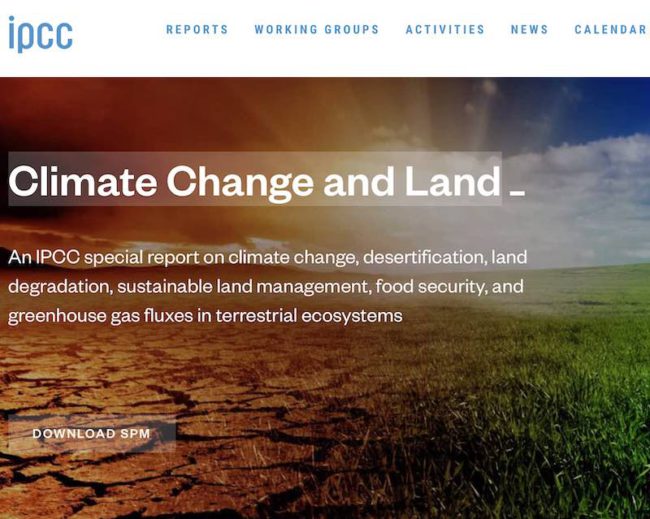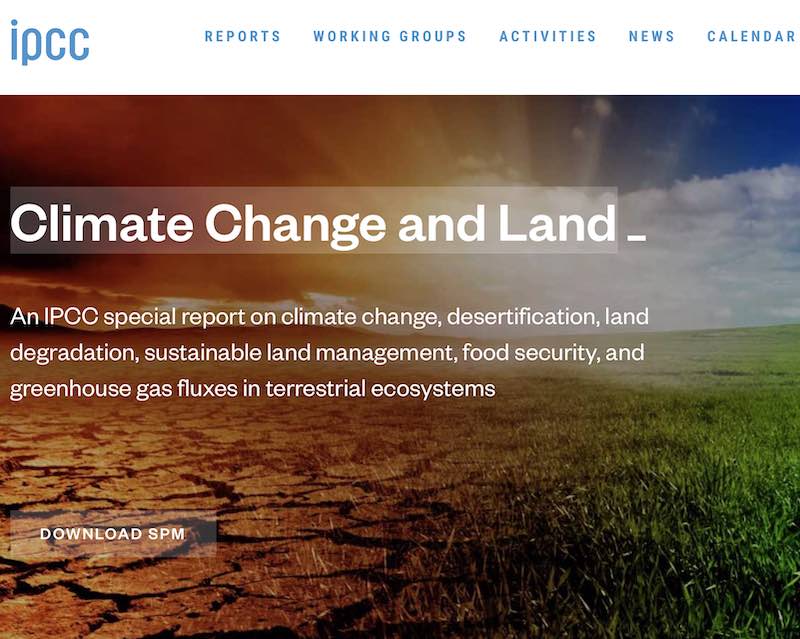
Yesterday, 8th Aug 2019, the IPCC published a Special Report on Land Use. To be a tad more precise, this is an IPCC special report on climate change, desertification, land degradation, sustainable land management, food security, and greenhouse gas fluxes in terrestrial ecosystems.
Work on the report was initiated back in 2016, and since then been worked on by 103 experts from 52 countries who were selected as Coordinating Lead Authors. They have all been working hard on pulling together this robustly evidence-based scientific report
Key Point: This is not an Opinion report, it is a comprehensive scientifically backed document that has been very carefully reviewed and refined by the best available subject matter experts.
You can find it all here and download the various sections freely.
Policymaker Highlights
There is an exec summary, that you can find here. I’m skipping over that and jumping to the policymaker section.
I’ve basically mined the following highlights from the summary for policymakers section. This is not explaining it to the public, but rather is what they are advising those that need to make meaningful decisions …
A. Land and Climate
A2. Since the pre-industrial period, the land surface air temperature has risen nearly twice as much as the global average temperature (high confidence). Climate change, including increases in frequency and intensity of extremes, has adversely impacted food security and terrestrial ecosystems as well as contributed to desertification and land degradation in many regions (high confidence). {2.2, 3.2, 4.2, 4.3, 4.4, 5.1, 5.2, Executive Summary Chapter 7, 7.2}

A3. Agriculture, Forestry and Other Land Use (AFOLU) activities accounted for around 13% of CO2, 44% of methane (CH4), and 82% of nitrous oxide (N2O) emissions from human activities globally during 2007-2016, representing 23% (12.0 +/- 3.0 GtCO2e yr-1) of total net anthropogenic emissions of GHGs21 (medium confidence). The natural response of land to human-induced environmental change caused a net sink of around 11.2 GtCO2 yr-1during 2007-2016 (equivalent to 29% of total CO2 emissions) (medium confidence); the persistence of the sink is uncertain due to climate change (high confidence). If emissions associated with pre- and post-production activities in the global food system22 are included, the emissions are estimated to be 21-37% of total net anthropogenic GHG emissions (medium confidence). {2.3, Table 2.2, 5.4}.
…
A4. Changes in land conditions25, either from land-use or climate change, affect global and regional climate (high confidence). At the regional scale, changing land conditions can reduce or accentuate warming and affect the intensity, frequency and duration of extreme events. The magnitude and direction of these changes vary with location and season (high confidence). {Executive Summary Chapter 2, 2.3, 2.4, 2.5, 3.3}
…
A 5. Climate change creates additional stresses on land, exacerbating existing risks to livelihoods, biodiversity, human and ecosystem health, infrastructure, and food systems (high confidence). Increasing impacts on land are projected under all future GHG emission scenarios (high confidence). Some regions will face higher risks, while some regions will face risks previously not anticipated (high confidence). Cascading risks with impacts on multiple systems and sectors also vary across regions (high confidence). {2.2, 3.5, 4.2, 4.4, 4.7, 5.1, 5.2, 5.8, 6.1, 7.2, 7.3, Cross-Chapter Box 9 in Chapter 6, Figure SPM.2}
…
A5.1. With increasing warming, the frequency, intensity and duration of heat related events including heat waves are projected to continue to increase through the 21st century (high confidence). The frequency and intensity of droughts are projected to increase particularly in the Mediterranean region and southern Africa (medium confidence). The frequency and intensity of extreme rainfall events are projected to increase in many regions (high confidence). {2.2.5, 3.5.1, 4.2.3, 5.2}
A5.2. With increasing warming, climate zones are projected to further shift poleward in the middle and high latitudes (high confidence). In high-latitude regions, warming is projected to increase disturbance in boreal forests, including drought, wildfire, and pest outbreaks (high confidence). In tropical regions, under medium and high GHG emissions scenarios, warming is projected to result in the emergence of unprecedented29 climatic conditions by the mid to late 21st century (medium confidence)
…
A5.4. The stability of food supply30 is projected to decrease as the magnitude and frequency of extreme weather events that disrupt food chains increases (high confidence). Increased atmospheric CO2 levels can also lower the nutritional quality of crops (high confidence)….
B. Adaptation and mitigation response options
…
B6. Response options throughout the food system, from production to consumption, including food loss and waste, can be deployed and scaled up to advance adaptation and mitigation (high confidence). The total technical mitigation potential from crop and livestock activities, and agroforestry is estimated as 2.3-9.6 GtCO2e.yr-1 by 2050 (medium confidence). The total technical mitigation potential of dietary changes is estimated as 0.7-8 GtCO2e.yr-1 by 2050 (medium confidence). {5.3, 5.5, 5.6}
…
C. Enabling response options
C 1. Appropriate design of policies, institutions and governance systems at all scales can contribute to land-related adaptation and mitigation while facilitating the pursuit of climate-adaptive development pathways (high confidence). Mutually supportive climate and land policies have the potential to save resources, amplify social resilience, support ecological restoration, and foster engagement and collaboration between multiple stakeholders (high confidence). {Figure SPM.1, Figure SPM.2, Figure SPM.3; 3.6.2, 3.6.3, 4.8, 4.9.4, 5.7, 6.3, 6.4, 7.2.2, 7.3, 7.4, 7.4.7, 7.4.8, 7.5, 7.5.5, 7.5.6, 7.6.6; Cross-Chapter Box 10 in Chapter 7}
…
C2. Policies that operate across the food system, including those that reduce food loss and waste and influence dietary choices, enable more sustainable land-use management, enhanced food security and low emissions trajectories (high confidence). Such policies can contribute to climate change adaptation and mitigation, reduce land degradation, desertification and poverty as well as improve public health (high confidence). The adoption of sustainable land management and poverty eradication can be enabled by improving access to markets, securing land tenure, factoring environmental costs into food, making payments for ecosystem services, and enhancing local and community collective action (high confidence). {1.1.2, 1.2.1, 3.6.3, 4.7.1, 4.7.2, 4.8, 5.5, 6.4, 7.4.6, 7.6.5}
…
C 4. The effectiveness of decision-making and governance is enhanced by the involvement of local stakeholders (particularly those most vulnerable to climate change including indigenous peoples and local communities, women, and the poor and marginalised) in the selection, evaluation, implementation and monitoring of policy instruments for land- based climate change adaptation and mitigation (high confidence). Integration across sectors and scales increases the chance of maximising co-benefits and minimising trade-offs (medium confidence). {1.4, 3.1, 3.6, 3.7, 4.8, 4.9, 5.1.3, Box 5.1, 7.4, 7.6}
D. Action in the near-term
D2. Near-term action to address climate change adaptation and mitigation, desertification, land degradation and food security can bring social, ecological, economic and development co-benefits (high confidence). Co-benefits can contribute to poverty eradication and more resilient livelihoods for those who are vulnerable (high confidence). {3.4.2, 5.7, 7.5}
…
D 3. Rapid reductions in anthropogenic GHG emissions across all sectors following ambitious mitigation pathways reduce negative impacts of climate change on land ecosystems and food systems (medium confidence). Delaying climate mitigation and adaptation responses across sectors would lead to increasingly negative impacts on land and reduce the prospect of sustainable development (medium confidence). {Box SPM.1, Figure SPM.2, 2.5, 2.7, 5.2, 6.2, 6.4, 7.2, 7.3.1, 7.4.7, 7.4.8, 7.5.6; Cross-Chapter Box 9 in Chapter 6, Cross-Chapter Box 10 in Chapter 7}
IPCC Report – Bottom Line
The Guardian nicely sums up the situation we all face as follows …
The climate crisis is damaging the ability of the land to sustain humanity, with cascading risks becoming increasingly severe as global temperatures rise, according to a landmark UN report compiled by some of the world’s top scientists.
Global heating is increasing droughts, soil erosion and wildfires while diminishing crop yields in the tropics and thawing permafrost near the poles, says the report by the Intergovernmental Panel on Climate Change.
Further heating will lead to unprecedented climate conditions at lower latitudes, with potential growth in hunger, migration and conflict and increased damage to the great northern forests.
The real question of the moment is this: There is very specific guidance within this report. It is not simply saying “Climate Change will be bad“, it also gives very specific guidance on what policymakers can actually do, so will the policymakers pay attention?
David Viner, a professor at the University of East Anglia and a senior IPCC author:
“Land is a vital resource and we have to look after it if we are going to have a sustainable future.”
IPCC Report: Further Reading
Carbon Brief (8th Aug 2019): In-depth Q&A: The IPCC’s special report on climate change and land …
The land provides the “food, feed, fibre, fuel and freshwater” without which human society and its economy “could not exist”, the report says. This provision is under threat from rising global temperatures and “unprecedented” rates of land and freshwater exploitation in recent decades, the report warns.
The full title of the report gives an indication of the catalogue of interlinked and overlapping issues it covers, including “climate change, desertification, land degradation, sustainable land management, food security, and greenhouse gas fluxes in terrestrial ecosystems”.
In this detailed Q&A, Carbon Brief unpacks what the report says about how climate change affects the land and vice versa, as well as other key topics such as food security, negative emissions and how to tackle the overlapping challenges associated with how humans use the land.
- Why did the IPCC produce this report?
- What is land degradation?
- How does climate change affect land degradation?
- How does the land contribute to climate change?
- What does the report say about desertification?
- What are the wider impacts of climate change-driven land degradation?
- How can climate change affect food security?
- How important are socioeconomic changes for future land degradation?
- How could ‘negative emissions’ affect land, food and wildlife?
- How are the issues linked and what solutions exist?
- What does the report say about sustainable development, gender and the role of indigenous communities?
- What has the reaction been?
Aug 7th) Farming Our Way Out of the Climate Crisis
Early tomorrow, the Intergovernmental Panel on Climate Change (IPCC) will release a new report that highlights the importance of land use and agriculture in climate change.
Good! It’s a crucial area for us to focus on, and it’s often neglected.
I’ve been working on this topic, on and off, since the 1990s, and have been a little bewildered why it doesn’t get more attention. For some reason, when we think of climate change and greenhouse gas emissions, we envision factories, cars, and smokestacks — not farm fields, plantations, and cattle ranches. But, it turns out, land use and agriculture are among the biggest contributors to climate change — and can be among the biggest climate solutions.
The Atlantic (8th Aug 2019) : This Land Is the Only Land There Is …
There is no shortage of scary facts in the major new report on climate change and land, a summary of which was released today by a United Nations–led scientific panel. Chief among them: For everyone who lives on land, the planet’s dangerously warmed future is already here. Earth’s land has already warmed more than 1.5 degrees Celsius (2.6 degrees Fahrenheit) since the industrial revolution, according to the Intergovernmental Panel on Climate Change. That’s the same amount of warming that climate activists are hoping to prevent on a global scale.
